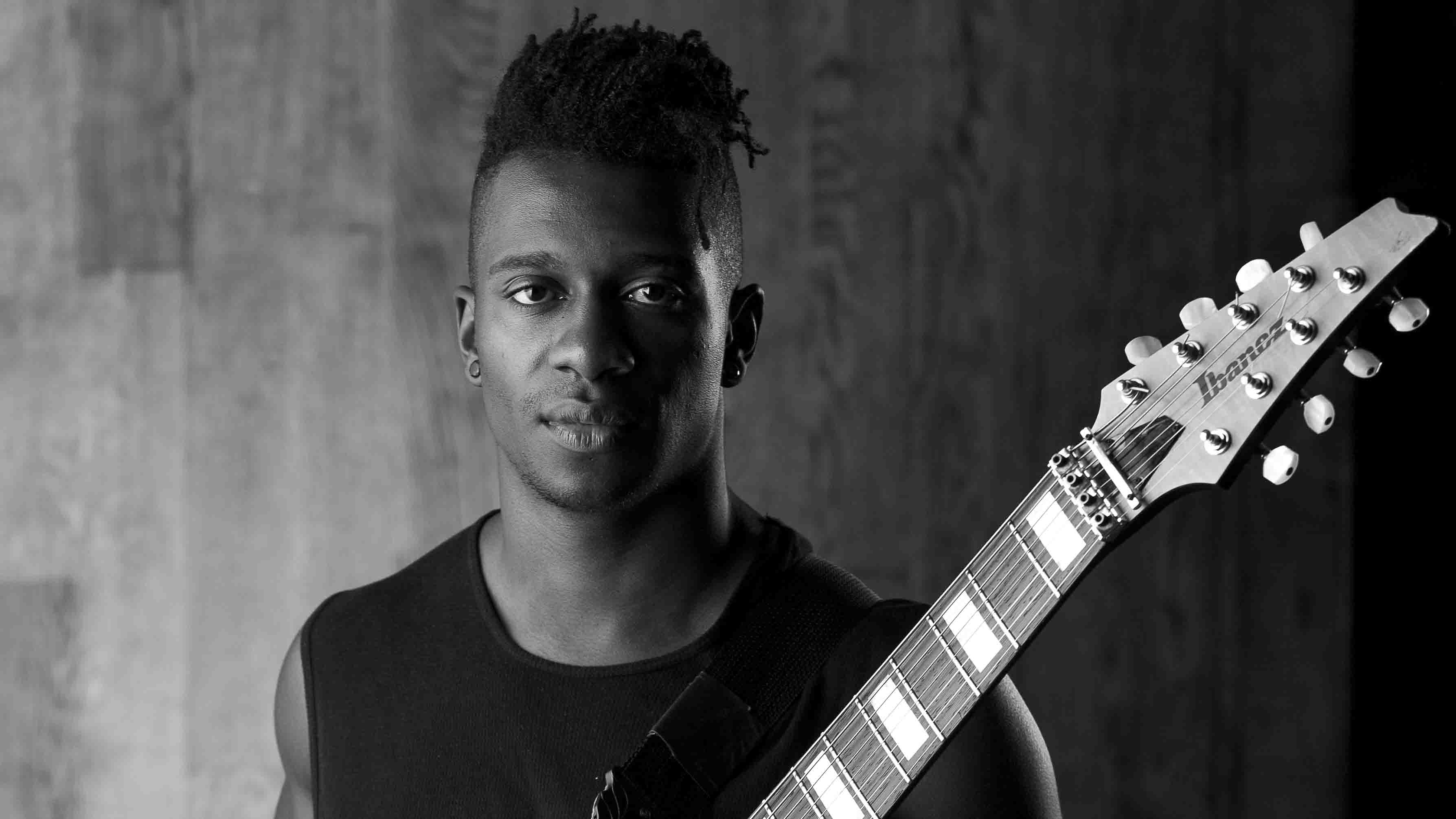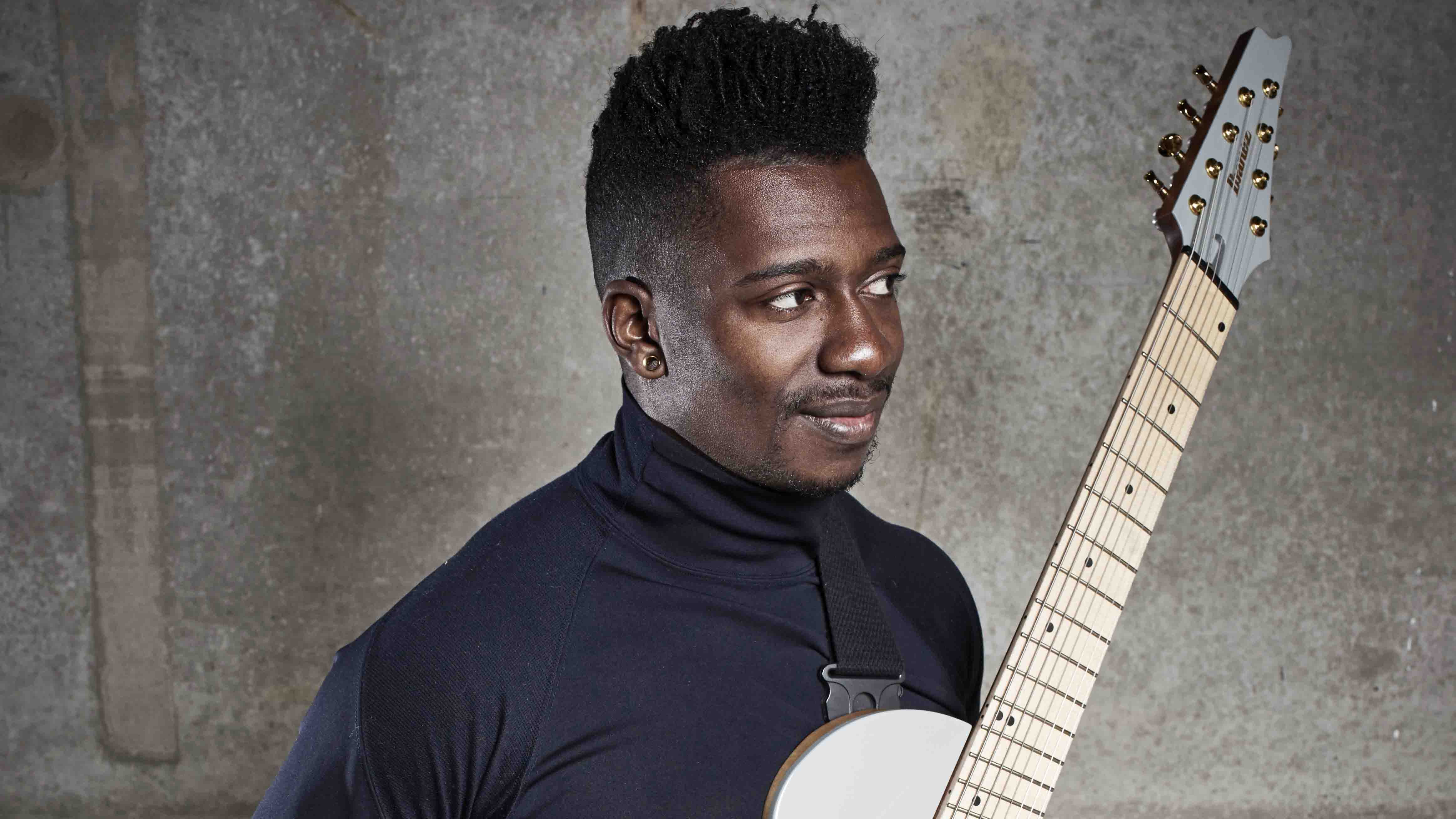Animals As Leaders' Tosin Abasi: my top 5 tips for guitarists
Eight-string virtuoso talks technique, phrasing and Generation Axe

The Madness Of Many
When you hit play on The Madness Of Many - the fourth studio album from American instrumental trio Animals As Leaders - you’d be forgiven for thinking you’d accidentally stuck on The Chemical Brothers.
At least for the first 10 seconds or so, after which its shifting sands and polymetric grooves pull the rug from under your feet and take you on a thundering pilgrimage through tech-metal, jazz-rock fusion and everything in between.
The opener isn’t the only track to throw such musical red herrings. Guitarist Tosin Abasi, joined by fellow eight-stringer Javier Reyes and sticksman Matt Gartska, is one to welcome comparisons far beyond that of the typical world of metal.
“It’s cool to hear The Chemical Brothers comparison,” he laughs, “because I think there’s a few tracks on this album that really don’t sound like music made with guitar and drums, at least from what I know of. We wanted to create an original space and really start blurring the lines between genres.”
Much like the progressive alchemists’ last effort, The Joy Of Motion, the new offering showcases a much more restrained side to Tosin’s playing. Compared with the blistering speeds hit on the eight-finger tapping and mega-sweeps in the videos that went viral almost a decade ago, his newfound minimalism could almost be mistaken for a different player altogether.
For many, he’s done the impossible – learning how to play a million notes, only to cherry-pick a select few and say more with less…
I’m not really responding to what people want to hear, but rather different things I like in lead playing, which at the moment is more vocal-style phrasing
“That’s just where I’m at as a player,” he explains. “I’m not really responding to what people want to hear, but rather different things I like in lead playing, which at the moment is more vocal-style phrasing. I’m getting more into bends and listening to slide guitar, which brings new influences to what I do.”
You have to wonder what kind of players could impression such an already consummate musician…
“As far as restraint goes, I’ve been listening to a lot of Derek Trucks,” Tosin reveals. “Because he plays slide, he can’t do a sweep arpeggio, if you know what I mean? On slide, you’re usually limited to one note on one string. It might just be his intuition, but that guy phrases like a gospel singer. There’s just something really impactful about it.
“A lot of people have known about him for a while; I guess I’m late to this party… which is fine, ha ha! Then there’s also Eric Gales, who is mindblowing, and Isaiah Sharkey – both of which aren’t shred guitarists, but they definitely have chops. They come from the tradition of backing up vocalists, and their phrasing really shows that.”
Earlier this year, the 33 year-old American was invited on the Generation Axe tour across North America – a relative newcomer and young face among the very gods of guitar in Zakk Wylde, Yngwie Malmsteen, Steve Vai and Nuno Bettencourt. As far as living the dream goes, it’s a level of recognition that only comes in a guitar player’s wildest fantasies…
“I think playing on that tour had something to do with how the album came out, too,” reveals Tosin.
“Those guys are quintessential lead guitar players and I would watch them all every night. As diverse as they are, they’re coming from more of a rock foundation and core. It’s kinda infectious… so the shredding is definitely alive and well for me!
“But right now, I feel more motivated in choosing the notes I play super-deliberately, rather than playing just a ton of notes. I’m also improvising a lot more on this album, too, which made it sound different phrasing-wise compared to what I’ve done before.”
Given his current headspace, now seems as good a time as any to get Tosin's top 5 tips for guitarists. Listen up…
Don't Miss
Animals As Leaders' Tosin Abasi: 10 essential guitar albums
Animals As Leaders' Javier Reyes: my top 5 tips for guitarists
Animals As Leaders' Matt Garstka on his journey to being the band's first live drummer on record

1. Know your intervals
“Learn the major scale and all of its diatonic modes and chords, then learn all the scales intervallically – so, playing in 3rds, 4ths, 5ths, 6ths and 7ths. Understanding these intervals will allow you to have a lot more feeling in your phrasing. It will bring much more tonality to how you play, for sure.
“Then try to combine these intervals in as many possibilities as you can come up with, like going from the root to the 4th, up one step to the 5th, and then down a 4th from there. Create different combinations and say the intervals out loud to yourself. That will help ingrain what each interval is and more about its relationship to the root.
“Later on, you might be trying to voice a chord and need to quickly find an extension - and that’s the kind of foundation work that will help you memorise where the right notes are. Carl Verheyen is amazing at it.”

2. Learn how to divide time
“Use the metronome for a lot of your practice and start with tempos you can pull off without much strain, and then you increase it from there. I honestly believe the metronome is central to producing good technique.
“There’s a point where any student has to make sure they are being musical in how they practice. 16th notes aren’t the only subdivisions that matter!
“Start doing cycles of five, quintuplets, or triplets in four-note scale fragments. That will displace every fourth note and help you tap into polymetric ideas that you can later use when playing over odd-meter music or whenever you want your phrasing to run over the bar.”

3. Study classical pieces
“I also think it’s important to learn some beginner to intermediate classical guitar. The open right hand is an under-utilised part of electric guitar playing, in my opinion. Whether you want to play rock or bluegrass or folk or flamenco… learning these pieces will help.
“If you look up Agustín Barrios Mangoré or just search Barrios - his stuff has a very cool sound that I think a lot of metalheads would like when it comes to classical music. It’s challenging enough to develop your technique, but it’s not impossible for beginner or intermediate players.
“Plus they’re great tunes to learn. Las Abejas is one of my favourites, along with La Catedral… I can’t say it properly in Spanish, though, because my Spanish sucks!”

4. Pick up a real book
“Learn some jazz standards, because that will show you how harmony works within keys and will ultimately help you understand voicings better. It really blurs the line as to how guitarists think – a lot of players look at scales and don’t realise that chords are simply certain notes played simultaneously.
“Once you’ve figured out the standards, especially the ones where you have to play the melody and chording at the same time, that will really expand your perception of the fretboard.
“It’s harmonically different to classical because it goes into chord extensions, using dominants and various other tonalities. That type of music is pretty much harmony central! Melodic minor is one of my favourite tonalities, and doing this will help you understand more about that scale specifically.”

5. Don't forget other instruments make music, too!
“Don’t be afraid to look at other instruments, from bassists to horn players to pianists… even listen to electronic music. It’s really interesting how a lot of that stuff utilises arpeggiators in an instrumental context.
“By understanding how those compositions work, you’ll see another side to how groove and melody can be compelling enough alone - without vocals - to make great music. We don’t always have to look to players of our own instrument to improve, and it’s quite easy to forget that as a guitarist.”
Don't Miss
Animals As Leaders' Tosin Abasi: 10 essential guitar albums
Animals As Leaders' Javier Reyes: my top 5 tips for guitarists
Animals As Leaders' Matt Garstka on his journey to being the band's first live drummer on record
Amit has been writing for titles like Total Guitar, MusicRadar and Guitar World for over a decade and counts Richie Kotzen, Guthrie Govan and Jeff Beck among his primary influences. He's interviewed everyone from Ozzy Osbourne and Lemmy to Slash and Jimmy Page, and once even traded solos with a member of Slayer on a track released internationally. As a session guitarist, he's played alongside members of Judas Priest and Uriah Heep in London ensemble Metalworks, as well as handling lead guitars for legends like Glen Matlock (Sex Pistols, The Faces) and Stu Hamm (Steve Vai, Joe Satriani, G3).
